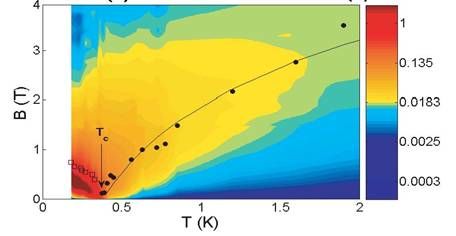Superconducting Fluctuations
Short-lived Cooper pairs detected by measuring their Nernst signal
When a superconductor is warmed up above its critical temperature, long-range order is destroyed, but fluctuating Cooper pairs survive. Recently, thanks to a high-resolution Nernst experiment on an amorphous superconductor, we detected one of the signatures of their presence in a wide range of temperature and magnetic field[1,2].

 Fig- Logarithmic color plot of the Nernst signal in Nb0.15Si0.85 revealing the presence of superconducting fluctuations at fields and temperatures exceeding Hc2 and Tc.
Fig- Logarithmic color plot of the Nernst signal in Nb0.15Si0.85 revealing the presence of superconducting fluctuations at fields and temperatures exceeding Hc2 and Tc.
Fig- Logarithmic color plot of the Nernst signal in Nb0.15Si0.85 revealing the presence of superconducting fluctuations at field For more information, please contact us or have a look on our publications :
Reference :
[1] A length scale for the superconducting Nernst signal above Tc in Nb0.15Si0.85
A.Pourret, H. Aubin, J. Lesueur, C. A. Marrache-Kikuchi, L. Bergi, L. Dumoulin & K. Behnia, Phys. Rev. B 76, 214504 (2007)
[2] Observation of the Nernst signal generated by fluctuating Cooper pairs
A. Pourret, H. Aubin, J. Lesueur, C. A. Marrache-Kikuchi, L. Bergi, L. Dumoulin and K. Behnia, Nature Phys. 2, 683 (2006)


